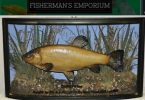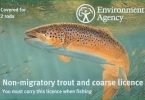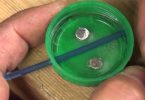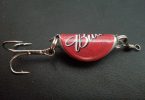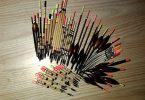She rests gently in my hands. Gills flaring slightly as I hold her head into the tide. Recovering from the indignity of being measured, weighed and photographed in the arms of a grinning land creature.
Her fins, stroking the water, and her tail waving slowly, she is ready to go, but doesn’t.
Perhaps she appreciates the warmth of my hands, maybe she understands my own need to keep surveying her poetic beauty with my eyes, as she masters the current. Fanciful thoughts.
Whatever! My hands are no longer holding her, she stays upright and still by herself. Her body, conditioned by the seas strong currents, full of power.
My arms still ache from the effort of playing her as the rod plunged time and again below the surface.
Time and again we battled. Me attempting to load line back onto my battered centrepin reel, she battling harder to strip it back off again. Then there are those tricks which only mullet seem to know, which had me expecting to lose the fish at any moment, leaving me with a slackened line and a sense of frustrated wonder.
My heart is still beating fast, partly with a kind of joy that only a fellow angler would understand.
She lifts her body and flicks her tail and for a moment I feel her power once more as she disappears like a grey ghost into the depths. And the joy in my heart soars.
I return her to the sea, not for any sentimental reason (well perhaps just a little), nor because mullet flesh is hardly worth eating (although that is true). But more importantly because, at 5lbs weight, she is already an old fish, important to the renewal of her kind.
I would guess that she is somewhere between 12 and 15 years old. I know that she probably spawned for the very first time in her tenth year, weighing around 3lbs, and that she will spawn only one year in every three from now on.
Perhaps we will battle again next season, when she will be bigger still. And she’ll be wiser now too.
But there is a coldness in the morning air. A sign that the summer has ended and soon the mullet will be gone.
As I gaze at the water, where she melted away, the coldness reaches into my heart.
It’s a coldness that comes with the thought that I may never see her again.
The thought that having released her, I will not be able to protect her.
It’s the same coldness that came to my heart, early in the year, when I read the email bringing news of a huge by catch of mullet by pair trawlers targeting the shoals of winter spawning bass. The same as last year, and the same I know as will come again next year.
When the email comes this coming winter, measuring the by catch in tonnes, will her 2.25 kilograms be added to the catch weight? Has she really spawned for the very last time?
And what of the spawning bass?
Fish which can live some 25 years, growing to perhaps in excess of 20lbs, spawning 15 times.
Nowadays, not many now make it to, or past, their first spawning at around 4lbs in weight, just 4 years old.
For thousands of years, the bass have gathered together to spawn. A winter feast for dolphins, able to balance their hunger with the need to sustain the shoals for the generations to come.
Now technology has found them. Powerful vessels, working in pairs, towing huge monofilament nets, the size of a cathedral, between them. Charging through the ancient spawning grounds at speed. Sweeping up everything in their path.
Protest to the authorities and the best answer that they can give is that the needs of anglers need to be ‘balanced’ against the needs to protect the livelihoods of fishermen ‘and their families’.
That often used phrase conveniently ignoring the livelihoods of all other stakeholders ‘and their families’. The inshore fishermen around the coasts of England and France, and the artisanal fishing communities of the Basque region. The charter skippers who make their living taking parties of anglers out in the expectation of catching big bass. The boat-builders that build boats for anglers, the marina owners who provide berths, the guest houses where they stay……….
When the sums are done, the landed value of the spawning bass shoals pales into insignificance beside the sums generated by recreational angling. As do the catch figures for recreational anglers when compared to the catch figures of the pair trawlers.
Now I see inshore fishermen once more raiding the ‘protected’ nursery areas where the immature bass grow in the estuaries. That makes me angry. But I understand.
When the bass nursery areas were established, there was an unstated promise that, if the bass were allowed to grow to spawning size, and to return to the open sea, they would come back bigger, and in greater numbers. And that inshore fishermen and anglers would reap a rich reward for their restraint.
Now there is a sense of betrayal. Why let the fish go, only to be taken by those far over the horizon?
What is the sense of giving away nature’s gifts to a few men, when they could yield far greater value if protected and allowed to increase, their reward to be reaped by many more men, and with far less destruction?
These thoughts are the coldness in my heart, as I stare into the water where she went.
But there are other thoughts that move my heart to a hotter anger.
The thought that as winter approaches, we will again see the carcasses of dolphins washed up on beaches.
Intelligent, warm-bloodied and social animals, slaughtered in their hundreds, as they too fall victim to the huge nylon nets, dragged at speed so that nothing can escape them.
Pingers may protect dolphins from blundering into stationary gill nets, as will reflective materials incorporated into these walls of death. Perhaps they would offer protection when used with ‘small’ nets towed behind a small boat. But such devices offer no protection to dolphins against a fine monofilament net, ¼ mile wide at the mouth, ½ mile deep, being dragged through the water at high speed by two powerful vessels.
And so the carcasses come ashore bearing the marks of the nets.
The flesh striped from the dolphin’s beaks as they struggled desperately to break free, their jaws twisted and broken as they fought against drowning, before becoming still.
Some bear the marks where the carcasses have been pierced to make them sink. So that the broken and mutilated bodies of dolphins which do get washed ashore remain but fragmentary evidence of a far greater hidden slaughter that occurs beyond the distant horizon.
As I gaze out toward the open estuary, where she must swim as the coldness comes, I feel a pang of self-recrimination. A guilt that despite my protests last year, and the year before, the killing continues.
Guilt that I allowed the relief I felt, when the winter pair trawl season ended last year, lull me into a time of inaction.
Wanting… no needing, to enjoy the coming season, and to put the horrors of the winter behind me.
Now the winter comes again, and I haven’t done enough.
As I take time, once again to put pen to paper, I’m haunted by the thought that others are making ready to send the trawlers back to the spawning grounds, having done their calculations of expected profits.
Will next year be any different?
It will only be different if the politicians and bureaucrats are given the courage to act. They need the comfort of many people behind them to act courageously themselves. They will only ever take action if they feel that the political will exists to do something about it. And they will only feel that the political will exists when they get a letter from you.
Will next year be any different?
Please take a few minutes to write to:
Franz Fischler
European Commissioner for Agriculture and Fisheries
200, Rue de la Loi
B – 1049
Brussels, Belgium
Margot Wallstrom
Commissioner for the Environment
200, Rue de la Loi
B – 1049
Brussels
Elliot Morley
DEFRA
Nobel House
Smith Square
Westminster
London SW1P 3JR
Also write to your MP, MEP (you can find their name and address via the SACN site) or, if you live outside the UK, your local representative.
We have just a little while until the winter slaughter begins again.
Leon Roskilly
Sea Anglers’ Conservation Network (SACN)
Please help by passing this article on to anyone you feel may also be able to help.
Please also feel free to publish it, but please include the link to the SACN website.


